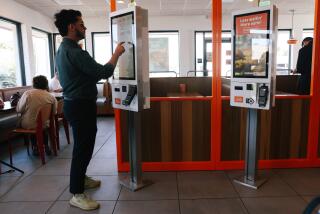Wal-Mart and Google team up on voice-activated shopping, challenging Amazon
A decade from now, most American consumers will routinely order laundry detergent, paper towels, groceries and other household staples using a voice-activated digital assistant, then have the items shipped to their homes.
That thinking has helped give rise to a suite of new tech gadgets in recent years and, as of Wednesday, a first-ever partnership between the world’s largest retailer, Walmart, and the Internet’s biggest search and advertising company, Google.
“The importance of this announcement cannot be overestimated, for them and for everyone,” said Karsten Weide, vice president for media and entertainment at the research firm IDC.
Google and Wal-Mart, both chasing e-commerce king Amazon.com Inc., said Wednesday their partnership would enable shoppers to make voice-ordered purchases of “hundreds of thousands of items” from Wal-Mart through Google, starting in late September.
That includes joining the Google Express online shopping marketplace website and smartphone app, and using Google’s voice-powered assistant, Google Home, which competes with Amazon’s industry leading Echo device, featuring the Alexa voice service.
The partnership adds to Google’s effort to catch up in the market for voice-based assistant devices, and by extension protect its dominant Internet search engine, which many consumers use for online shopping.
Google Express already has such retailers as Target Corp. and Costco Wholesale Corp. in its stable, and earns commissions from those merchants on orders it handles. But Google hopes Wal-Mart will make its voice-shopping unit even more attractive to consumers because Wal-Mart would offer the largest number of items in the group.
Amazon’s Echo had 74% of the U.S. home voice speaker market as of June 30 while Google Home had only 26%, according to research firm Consumer Intelligence Research Partners.
And among the Echo users, half had made some type of online purchase on the device with Alexa, the firm said.
“The future of retail is going to be voice shopping, or what’s called conversational commerce,” said Joe Feldman, senior managing director at Telsey Advisory Group.
For Wal-Mart, the partnership is the latest step in the retailer’s aggressive effort to close the gap with Amazon in e-commerce.
Wal-Mart already has made several e-commerce acquisitions in the last year, including mass-merchandise retailer Jet.com; lowered its shipping rates and improved the ease with which shoppers can pick up goods at Wal-Mart stores or have them shipped.
Wal-Mart sees voice ordering as “an important future application,” Feldman said. “They’re not a tech company, so it makes sense they would partner with somebody like Google.”
The retailer faces tough sledding in catching Amazon. In July, Amazon accounted for nearly 45 cents of each dollar spent online in U.S. e-commerce, while Wal-Mart accounted for a mere 1.9 cents, data from the digital-shopping research firm Slice Intelligence shows.
While one of Wal-Mart’s biggest advantages over Amazon is its 4,700 U.S. stores, Amazon’s nearly $14-billion offer for Whole Foods — which on Wednesday received the blessing of the Federal Trade Commission and Whole Foods shareholders — could shake up the landscape.
To be more competitive with Amazon, which offers same-day and even one-hour shipping options with its $99-a-year Prime membership, Google Express is scrapping the $95-a-year membership starting Wednesday, allowing shoppers to get free delivery within one to three days on orders as long as the purchase is above each store’s minimum.
Wal-Mart customers also would be able to link their Wal-Mart accounts to Google to create digital shopping lists for easier reordering.
“When it comes to voice shopping, we want to make it as easy as possible for our customers,” Marc Lore, chief executive of Wal-Mart’s U.S. e-commerce business, said in a statement.
That convenience will become more important to consumers as voice technology evolves and becomes more accessible, analysts said. The trend also could become a huge data boon for Google, which could gain further insight into consumers’ purchasing habits to aid Google’s advertising business.
“Today, consumers want to spend the least amount of time shopping for the products they care least about,” said Brendan Witcher, a retail analyst at Forrester Research. “For commoditized products, this is really the future of shopping.”
And recurring purchases, such as of groceries and household staples, are especially ripe for voice shopping because voice assistants will have stored a customer’s prior orders, said Brendan Miller, a principal analyst at Forrester.
“It’s good that Wal-Mart’s getting in on this now,” he said. “As this gets more complex and you start searching for auto parts or things more complex than ordering toothpaste, then Wal-Mart will be well-positioned.”
Google and Wal-Mart have little choice if they want to be long-term competitors in e-commerce, Weide said.
“When we look five or 10 years down the road, not a single consumer will mess around with a keyboard anymore; everybody will do their stuff through voice,” Weide predicted.
“The current [voice] devices are still primitive, but in 10 years they’ll be very smart and they’ll be everywhere,” he said. “You will have a personal assistant not only in your Google Home device or phone, it’s going to be in your TV set and in your car.”
Compared with shopping at brick-and-mortar stores, Weide said, “it’s much more efficient than people driving their cars to a big parking lot to shop.”
Times staff writers Samantha Masunaga and David Pierson and Times wires services contributed to this report.
UPDATES:
Aug. 23, 3:40 p.m.: This article was updated to include new staff reporting and mention of the Federal Trade Commission’s move to allow the Whole Foods deal to proceed.
Aug. 23, 8:25 a.m.: This article was updated with Whole Foods shareholders’ approval of the Amazon bid.
This article was originally published at 10:05 p.m. Aug. 22.
More to Read
Inside the business of entertainment
The Wide Shot brings you news, analysis and insights on everything from streaming wars to production — and what it all means for the future.
You may occasionally receive promotional content from the Los Angeles Times.











